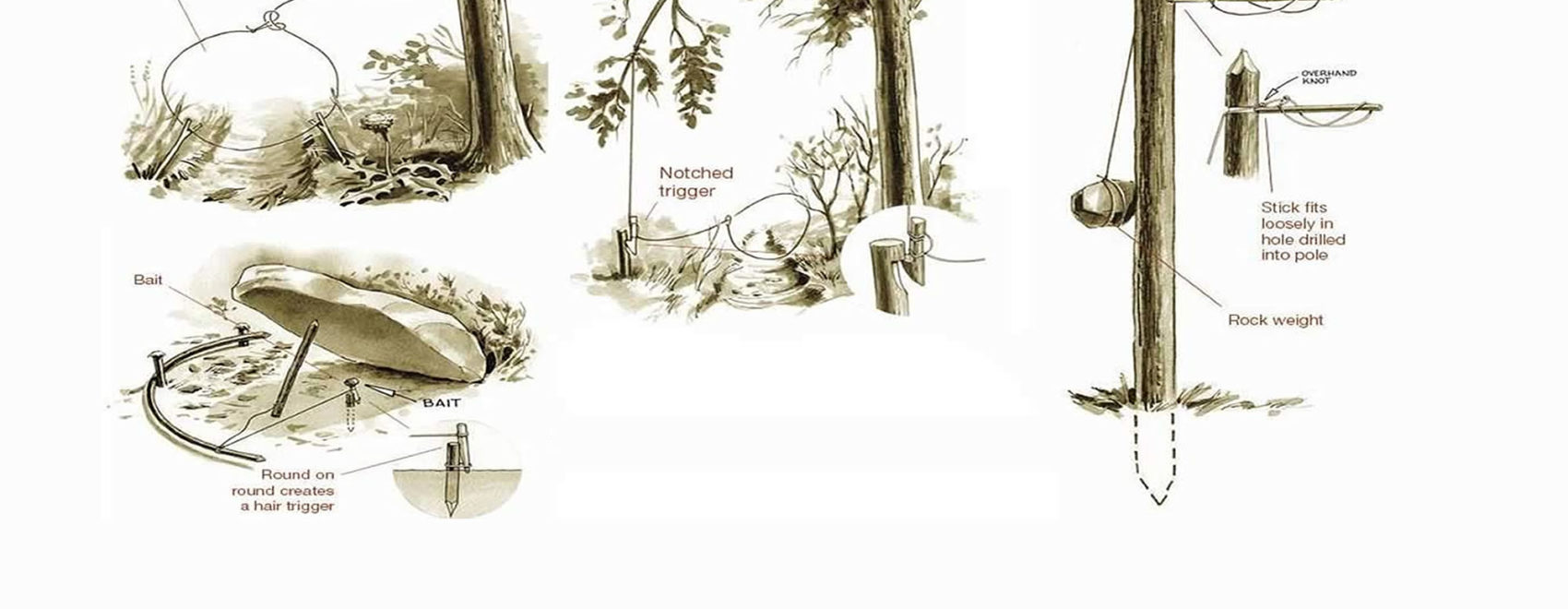Survival Trapping – What and Where to Trap
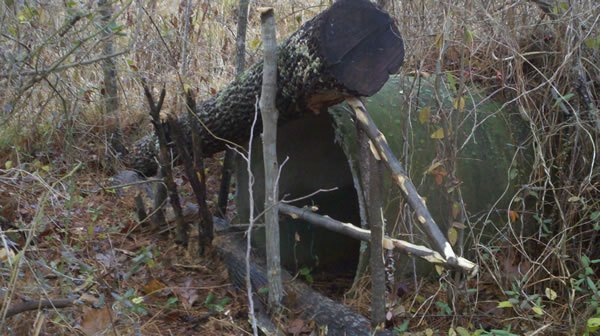
Trapping, or at least successful trapping, has to fit the environment. What you can trap depends on where you are. If the environment doesn’t include nutria (a semiaquatic rodent, “river rat”), for example, then it’s not a target species. For the purposes of survival trapping, the target species are primarily for food.
There is a point to making the distinction between trapping for fur and skins, and trapping for food. Weasel and mink, for example, are important targets for fur trapping; but because of their small size and other characteristics (like bad taste), are not target species for food.
On the other hand, beaver are historically vastly important for fur trapping but are also a viable target for food – if there are enough beaver in the environment. That’s availability, the second most important factor about target species in a given environment – are there enough of them to provide a useful source of food?
As mentioned in the introduction, trapping for food is a numbers game. Building and setting traps is time consuming, but more traps placed in appropriate locations increases the chances of catching game.
The key words here are appropriate locations. It’s axiomatic in the trapping business that “A good trap in a bad location is a bad trap.” If you don’t put traps where the target species are frequent – and likely to get into the trap – then it doesn’t matter how many traps you put out. This also assumes there are enough of the species where you set the traps.
So to summarize a bit, successful trapping for food means knowing what creatures are in the environment, which are abundant enough to try to trap, for which you can identify multiple locations to set traps, and are species suitable for human consumption.
Know the environment Where You’re Trapping
If you’re a typical prepper, you know where you’re going in a SHTF situation. If you’re not typical, or you are caught off guard, maybe you wind up in an unfamiliar place. Either way, one of the first tasks in any environment is to assess it for sources of food. Call it the “food environment.” Food in this case is inclusive of any natural source, plant or animal. The food environment is usually a limited area, typically no further than you can walk to and return from in a day.
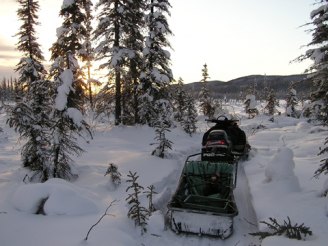
For the most part, establishing a food environment is like taking an inventory. You get out of camp and see what’s around you. If the terrain is familiar, you already know, roughly, where to look. If it’s unfamiliar, you probably need to cover more ground. You’re looking for places where edible things grow, such as berries or tubers. At the same time, you’re looking for animals or their signs – trails, food sources, and scat.
You’re also noting water: rivers, streams, lakes and ponds, which might be sources of fish, amphibians or reptiles. If you’re on or near the sea or a large lake, that automatically becomes a potential source of food. Don’t forget swamps. As people from the bayou can tell you, many edible things live in swamps; you just need a way to get them safely.
Looking for things to eat is easy to list, as in the previous paragraph. Doing it well – making an accurate and useful assessment – that takes knowledge and usually a lot of experience. We mentioned this in the introduction. Successful trapping depends on observation.
Good observation depends on developing knowledge and experience of the natural environment. Knowing what to look for and where to look for it, is the difference between slow inaccurate assessment and an efficient inventory effort, which can lead to successful trapping and plentiful food.
This kind of knowledge starts with big scale information, like what sorts of plants and animals you’re likely to find in deserts, or mountains, or plains, or swamps. Better yet, the knowledge is local; you know what edible species are found in the region and at what time of the year. Best of all, you already know what signs to look for.
The point of the inventory is to note in your head, on paper, or best of all on a map, where potential target species are located, their approximate abundance, and their availability. Then you use the inventory information to make decisions about what to trap. (At the same time, you’re probably also making decisions about what plants to forage and what larger animals to hunt.)
What to trap: Target species
Most places in the United States, or North America in general, the principle target for hunting is deer. That’s no surprise since there are tens of millions of deer, widely distributed to almost every corner of every state, and they’re a fairly large animal with a considerable amount of meat.
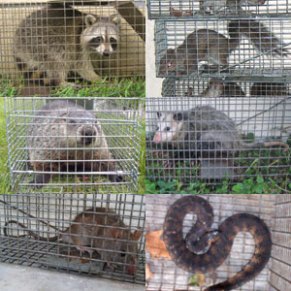
Wherever your bug out location is situated, there’s likely to be deer. By the way, people do build traps for deer and other large animals, but that’s a different scale of trapping, which requires more effort and considerable care. It’s a scale of traps that can also injure or kill people.
Most people associate trapping with smaller animals and species that are at least as ubiquitous as deer, namely rabbits and squirrels. However, trapping in various forms also includes slightly exotic small animals such as nutria, coyotes, fox, raccoon, opossum, beaver, woodchuck, nutria and wild boar.
People also routinely trap birds and fish. Trapping also includes reptiles (e.g. snakes) and amphibians (e.g. frogs), although outside of certain geographic areas (namely the South) these two are often forgotten.
One thing everybody needs to ditch, if the situation is truly a matter of survival, is aversion to certain kinds of food, in this case the taste of some meats. Many people don’t like “gamey” meats. That’s a preference, or bias, that needs to be overcome – “get over it.”
For example, it’s true that the meat of many mustelids (badgers, wolverines, otters, weasels, and skunks) has a peculiar flavor, but they are edible, especially if properly prepared. (On the other hand, as in the case of skunk roadkill, exceptions can be made.)
People also need to get over aversion to types of animals, for example, snakes. After all, rattlesnake meat, properly cooked, tastes like bland, chewy chicken or tilapia fish. Trapping a rattlesnake is a lot more exciting than eating it.
Taste preference is just one of five main factors in selecting target species for trapping, and it’s not the most important. Here’s the drill:
- Food value – The primary factor is how much food value you get from a species. Some animals, such as rabbit, taste good but actually don’t have a great deal of food value. Other animals, for example quail, are so small that you need a large number of them to make a meal. To the best of your knowledge, and this does take research, you start by targeting species that have the best food value.
- Abundance – At some point, for all species, abundance (or lack of it) is a factor. If there is only one fox in your ‘food environment,’ it’s probably not worth your time to hunt or trap the fox. It’s much better to focus on a species, say muskrats, which are more abundant.
- Availability – You can’t trap what you can’t reach. If it’s winter and the animal, for example a hedgehog, is hibernating. Then that’s not a target species. Likewise, some animals are simply hard to catch in a trap, crows are a good example (they’re smart). Selection of target species has to include how easy, or difficult, it is to trap them.
- Seasonal or climate factors – Many animals are best to eat in certain seasons. For example, during late winter or early spring, many animals are undernourished, weighing only a fraction of what they do in the fall. Fish that have recently spawned have lower food value and often don’t taste good. Seasonal or climate factors don’t necessarily rule out a species, but they can establish preferences among species.
- Taste and variety – Obviously taste is subjective and may or may not be connected to food value, but human beings have preferences and at least occasionally trapping for taste (rabbits again) is the right thing to do. Then there is the matter of variety. In general, people like some variety in their food. Nutritionally, there are differences even among similar species, but certainly between fish and mammals. Fish have large quantities of protein and amino acids, and some species, such as salmon, have beneficial fatty acids such as Omega 3. That means, if possible, alternating between trapping animals and fish is a good strategy.
While food value (#1) is probably the most important factor in selecting target species, it’s part of a dynamic assessment. Maybe a very abundant animal (#2) that is easy to catch (#3), again with the rabbits, should be preferred over a more nutritious animal, nutria for example. Or a larger animal, say a wild boar or peccary, is worth the effort even though rabbits are easier to catch.
The main thing is to assess the local environment and figure out which things you can trap that are nutritious, worth the effort to trap, relatively easy to catch, and are edible. If the emergency is likely to be long-term, as in several months or more, it’s probably important to consider how quickly a food species can renew itself.
Where to trap: Where the animals are (going)
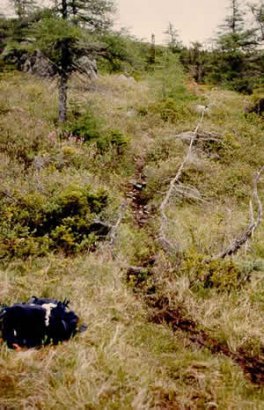
It seems easy and intuitive that traps are set where the animals are. Yes, of course, but determining where animals are, in general, is one thing. Determining where they will be at the time you set traps, is something else. Then there’s also the point that many traps, such as snares and deadfalls, require the animal be moving, usually in transition from one place to another.
Effective placement of a trap is perhaps the most crucial step in successful trapping. It requires the closest observation of the existing environmental conditions and a detailed knowledge of species behavior. It’s something like a mousetrap. Set a bare mousetrap and place it where mice can get at it, and the chances of a random mouse stepping into it are almost nil.
Put a dab of peanut butter on it and snap! It works because you know mice can’t resist peanut butter (or cheese, or bacon). So some traps, with some species work best with bait. Other traps, such as a sling (noose or loop), work without bait but presume the trap is oriented to a path where the target moves through it. In that case, you need to have identified paths or runs frequented by the animal.
In any area where you’ve identified a target species is active and relatively abundant, there are probably multiple locations where a trap could be set. The challenge is to select those locations where the target is most likely to go. For example, many animals, such as a fox or badger, will approach a small pond or pool to drink (especially in the dry season) and the tracks tend to follow specific paths to the water’s edge. It’s almost a sure bet that sooner or later the target animal will visit the pool, so setting a trap on that path (or paths) should be a high priority.
Similar thinking applies to locations where there is a favorite food, an obvious place for defecation (mice do this), or trails that lead to active dens or nests. Fish have a different kind of logic, obviously oriented to the water, so that current direction and speed, hiding places, time of day all play a role in setting a fish trap. This kind of thinking is the same as an angler, only with fish traps, you’re thinking of a passive catch and multiple fish.
It should be clear that effective placement of traps depends on accurate knowledge of the animal’s behavior and the ability to read the environment to predict where the animals are most likely to go. With that, comes the selection of the appropriate type of trap and its setup. How to trap the target species – which traps to use and how to set them – is the subject of the next tutorial: Survivalist 101 Tutorial: Survival Trapping – Some Basic Traps.

